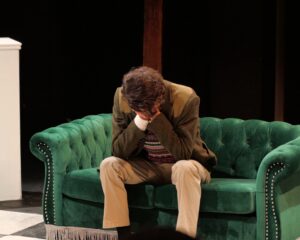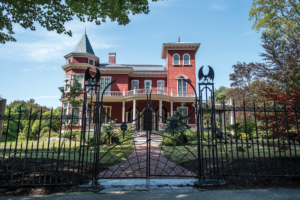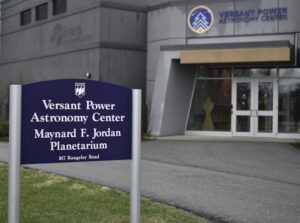On March 3, Archaeologist Gabriel Prieto gave a lecture about ritual sacrifice on Peru’s coast to a packed room in the Bodwell Area in the Collins Center for the Arts. University of Maine Professor of Archaeology Dr. Dan Sansweiss introduced Dr. Prieto, an assistant professor at the University of Florida at Gainesville, professor at Peru’s National University of Trujillo, and National Geographic grantee.
“It’s very rare to not find [examples of] human sacrifices in different societies around the world, and that it’s something that is embedded in human cultural practices,” Prieto said in the opening, framing the several human sacrificial sites he’s investigated. The sites Prieto analyzed were mainly child and camelid, meaning of the camel family, sacrificial sites. Prieto went on to explain the environment in Peru and how its variability and volatility led to the societies he examines being developed under strenuous circumstances, and that ritual sacrifice was indeed tied into this relationship.
Using other sites in the region for reference, Prieto made the case that “violence was closely related to [these people’s] ideological beliefs,” and that sacrifice was an extension of this. Archaeologists have known for decades that the people in question, the Moche, and later Chimu, practiced human sacrifice in the region, but previous archaeological finds were not nearly as encompassing as Prieto’s current undertaking.
The first site, Huanchaco, is not far from the infamous archaeological site of Chan Chan, once a large Chimu city. Prieto noted that he cannot currently dig in the Chan Chan, as the Peruvian government is currently doing its own excavations, but is doing his best to dig around. He also spoke of the El Nino occurrences and the effect these likely had on the Chimu economy and society, adding that he thinks the answer to the reaction the Chimu had is found at sites like Huanchaco.
Prieto’s work started in 2011 when he got a call from a local business owner who said he had noticed his children playing with human bones. Prieto remarked that in a place like Peru, it’s not uncommon for people to come across ancient artifacts.
“It seems like everyone has some sort of ancient ceramic vessel lying about,” Prieto said of the number of ancient artifacts in Peru. In this case, the owner’s property yielded 43 children and 43 llama sacrifices, numbers much higher than Prieto expected. He then decided to put together a team to tackle the growing project.
The team, consisting of a forensic anthropologist, zooarchaeologist and archaeologist, was able to secure funding via National Geographic grants that allowed them to explore the archaeological phenomenon. In total, they discovered the remains of 137 children and 205 llamas. Most of the children ranged from ages six to 11, with DNA analysis showing them to have been both male and female. Almost all the children were buried with at least one young llama.
The team discovered that the sacrifices were likely carried out together in one large event. All the children’s chest cavities were opened with extremely clean cuts to the sternum, which is not typical.
“Usually there is some hesitation in the executor or the victim moves, causing imperfect cuts,” Prieto explained. He went on to suggest that it’s possible, as it was not an uncommon practice, that the heart was then removed from the chest cavity as a sort of “transfer of power.”
Adding to this theory was the discovery of a 40-year-old man on the sacrificial grounds that had an extremely strong right arm, which suggests he might have been the executor. Prieto explained that in some human sacrificial cultures, the executor is killed after he performs the executions as he is seen to have acquired the power of his victims, and if the organizer wanted that power he would have to kill him.
Prieto’s team also found data that showed the children were in excellent health upon their death.
“[Their health] shows they were not just kids taken from the streets to be used in the sacrifice, and that they likely didn’t come from poor families,” Prieto added. He talked about the children’s ethnic affiliation and geographic location, suggesting that occipital flattening of the skull in about 10 percent of cases alludes to variation.
Prieto is currently digging at a second site where the number of sacrificial victims is already surpassing the Huanchaco site, with the remains of around 230 children and over 400 llamas. He made note of the many conditions that inhibit his work, such as variable weather conditions, difficulty in working in the sand and damage to sites. The second site is especially interesting to Prieto as it represents an era in Chimu history where the Inca were also present. Prieto said that with this site, he was confident that sacrifices were used “as a form of political discourse” and not just as a result of El Nino weather occurrences.
Prieto closed out the lecture by talking about how he was looking forward to future excavations and discoveries, as there is much potential in the region. The event was sponsored by the Rising Tide Center in partnership with the UMaine Unido project, helmed by professors Dr. Dan Sandweiss and Carlos Villacorta, which aims to bring speakers from Latin and South America to UMaine.










